
Concept explainers
(a)
Interpretation:
The Lewis formula of
Concept Introduction:
Lewis Structure: A Lewis structure shows a covalent bond as pair of electrons shared between two atoms.
Procedure to write Lewis formulas:
- 1) The symbols of the atoms that are bonded together in the molecule next to one another are arranged.
- 2) The total number of valence electrons in the molecule is calculated by adding the number of valence electrons for all the atoms in the molecules. If the species is an ion, then the charge of ion into account by adding electrons, if it is a negative ion or subtracting electrons if it is a positive ion.
- 3) A two-electron covalent bond is represented by placing a line between the atoms, which are assumed to be bonded to each other.
- 4) The remaining valence electrons as lone pairs about each atom are arranged so that the octet rule is satisfied for each other.
Formal charge (F.C): The charges that assigned to each atom in a molecule or ion by a set of arbitrary rules and don not actually represent the actual charges on the atoms are called as formal charges.
The formal charge is calculated using the formula,
The Lewis structure with zero formal charge or least separated formal charges is the preferred structure of the molecule.
(a)
Explanation of Solution
The total number of valence electrons in
Number of valence electrons in nitrogen=
Number of valence electrons in fluorine=
Since there is a positive charge present in ion, one electron is subtracted.
The total number of valence electrons is thirty-two.
One nitrogen atom forms four bonds with fluorine that is eight electrons are used to form bonds and the remaining twenty-four atoms are used to satisfy the octet rule of fluorine atoms.
The Lewis formula is,
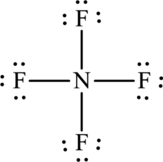
The formal charge for each atom is calculated as,
Formal charge on fluorine=
Formula charge on nitrogen=
The Lewis formula is,
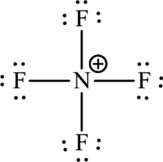
(b)
Interpretation:
The Lewis formula of
Concept Introduction:
Refer to part (a).
(b)
Explanation of Solution
The total number of valence electrons in
Number of valence electrons in chlorine=
Number of valence electrons in fluorine=
Since there is a positive charge present in ion, one electron is subtracted.
The total number of valence electrons is thirty-four.
One chlorine atom forms four bonds with fluorine that is eight electrons are used to form bonds and the remaining twenty-six atoms are used to satisfy the octet rule of fluorine atoms.
The Lewis formula is,
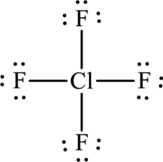
There are two unassigned electrons and the two unassigned electrons can be added to a chlorine atom. As chlorine is present in the third period, it can expand the octet rule.
The Lewis structure becomes,

The formal charge for each atom is calculated as,
Formal charge on fluorine=
Formula charge on chlorine=
The Lewis formula is,
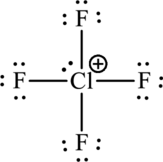
(c)
Interpretation:
The Lewis formula of
Concept Introduction:
Refer to part (a).
(c)
Explanation of Solution
The total number of valence electrons in
Number of valence electrons in phosphorus=
Number of valence electrons in hydrogen=
Since there is a positive charge present in ion, one electron is subtracted.
The total number of valence electrons is eight.
One phosphorus atom forms four bonds with hydrogen that is eight electrons are used to form bonds.
The Lewis formula is,

The formal charge for each atom is calculated as,
Formal charge on phosphorus=
Formula charge on hydrogen=
The Lewis formula is,

(d)
Interpretation:
The Lewis formula of
Concept Introduction:
Refer to part (a).
(d)
Explanation of Solution
The total number of valence electrons in
Number of valence electrons in arsenic=
Number of valence electrons in fluorine=
Since there is a negative charge present in ion, one electron is added.
The total number of valence electrons is forty-eight.
One arsenic atom forms six bonds with fluorine that is twelve electrons are used to form that bonds and the remaining thirty-six are used to satisfy the octet rule of fluorine atoms.
The Lewis formula is,
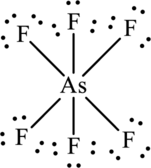
The formal charge for each atom is calculated as,
Formal charge on arsenic=
Formula charge on fluorine=
The Lewis formula is,
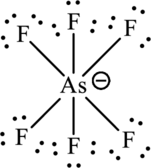
(e)
Interpretation:
The Lewis formula of
Concept Introduction:
Refer to part (a).
(e)
Explanation of Solution
The total number of valence electrons in
Number of valence electrons in bromine=
Number of valence electrons in fluorine=
Since there is a negative charge present in ion, one electron is added.
The total number of valence electrons is thirty-six.
One bromine atom forms four bonds with fluorine that is eight electrons are used to form that bonds and the remaining twenty-eight electrons are used to satisfy the octet rule of fluorine atoms.
The Lewis formula is,
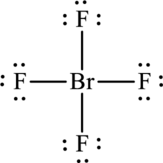
There are only thirty-two valence electrons and four electrons are left unassigned. The unassigned electrons are added to bromine atom. As bromine atom is present in the fourth period, it can expand the octet rule.
The Lewis structure becomes,
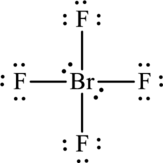
The formal charge for each atom is calculated as,
Formal charge on bromine=
Formula charge on fluorine=
The Lewis formula is,

Want to see more full solutions like this?
Chapter 7 Solutions
GENERAL CHEMISTRY ACHIEVE ACCESS W/BOOK
 ChemistryChemistryISBN:9781305957404Author:Steven S. Zumdahl, Susan A. Zumdahl, Donald J. DeCostePublisher:Cengage Learning
ChemistryChemistryISBN:9781305957404Author:Steven S. Zumdahl, Susan A. Zumdahl, Donald J. DeCostePublisher:Cengage Learning ChemistryChemistryISBN:9781259911156Author:Raymond Chang Dr., Jason Overby ProfessorPublisher:McGraw-Hill Education
ChemistryChemistryISBN:9781259911156Author:Raymond Chang Dr., Jason Overby ProfessorPublisher:McGraw-Hill Education Principles of Instrumental AnalysisChemistryISBN:9781305577213Author:Douglas A. Skoog, F. James Holler, Stanley R. CrouchPublisher:Cengage Learning
Principles of Instrumental AnalysisChemistryISBN:9781305577213Author:Douglas A. Skoog, F. James Holler, Stanley R. CrouchPublisher:Cengage Learning Organic ChemistryChemistryISBN:9780078021558Author:Janice Gorzynski Smith Dr.Publisher:McGraw-Hill Education
Organic ChemistryChemistryISBN:9780078021558Author:Janice Gorzynski Smith Dr.Publisher:McGraw-Hill Education Chemistry: Principles and ReactionsChemistryISBN:9781305079373Author:William L. Masterton, Cecile N. HurleyPublisher:Cengage Learning
Chemistry: Principles and ReactionsChemistryISBN:9781305079373Author:William L. Masterton, Cecile N. HurleyPublisher:Cengage Learning Elementary Principles of Chemical Processes, Bind...ChemistryISBN:9781118431221Author:Richard M. Felder, Ronald W. Rousseau, Lisa G. BullardPublisher:WILEY
Elementary Principles of Chemical Processes, Bind...ChemistryISBN:9781118431221Author:Richard M. Felder, Ronald W. Rousseau, Lisa G. BullardPublisher:WILEY





